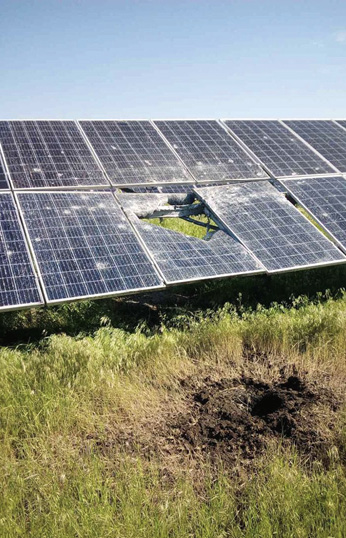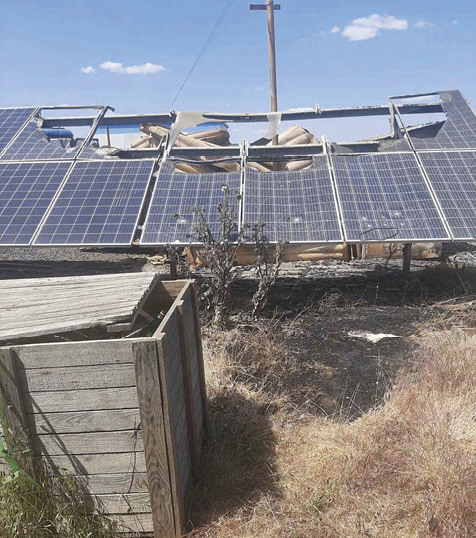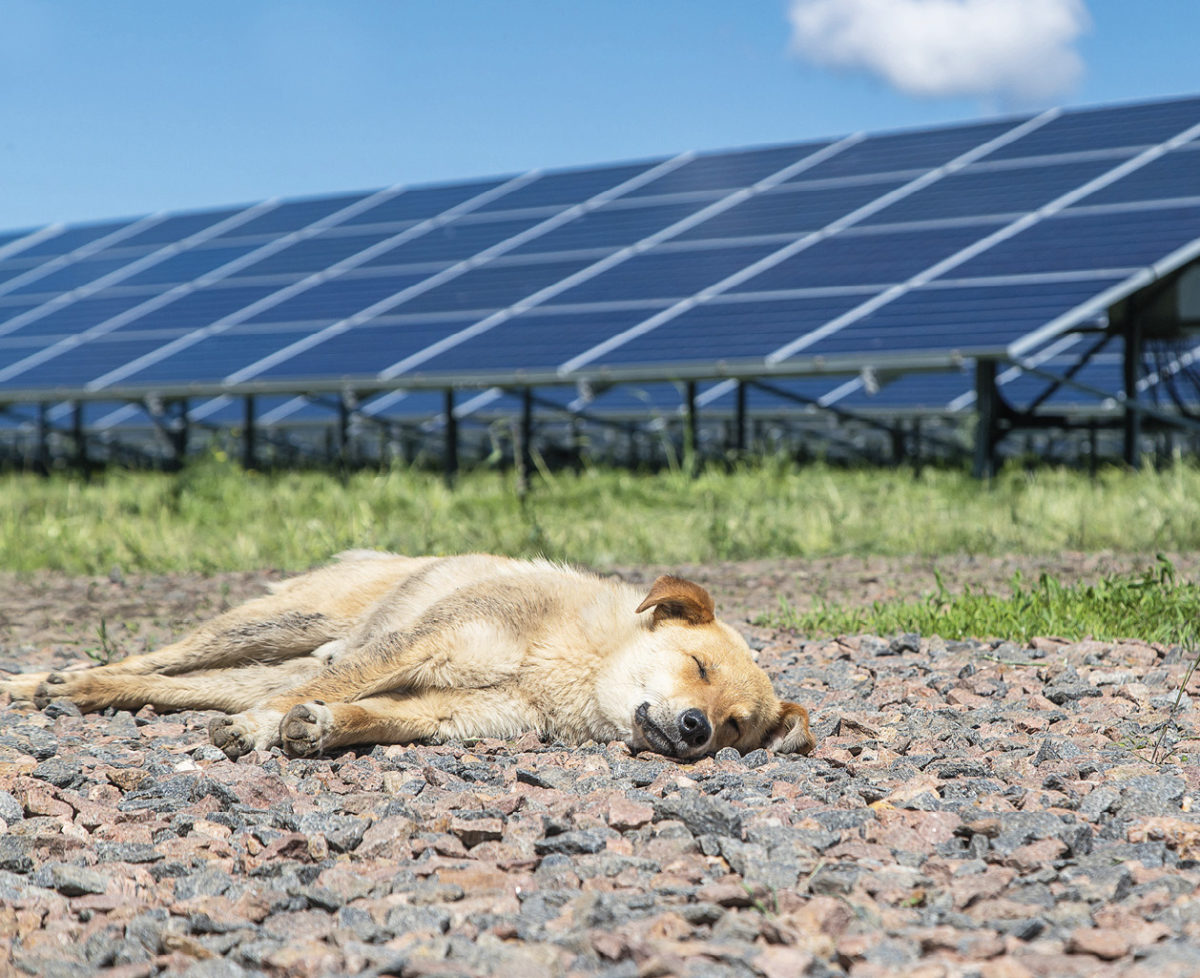From ISSUE 09 – 2022.
For a nation still very much in grave danger, optimism remains in Ukraine – and it extends to the energy sector. Once the war is over, Ukraine plans to spend a stunning $128 billion on rebuilding its power system, largely focusing on renewable energy sources. Ukrainian officials plan to collect the required funds from selling seized Russian assets and future reparations. Still, as the hostilities show no sign of letting up, it has left PV developers, as with much of the economy, facing terribly difficult times.
The Russian invasion has resulted in a massive outpouring of national solidarity in Ukraine, as the war united oligarchs and working people, the ruling party and opposition, the military and civilians, and groups right across Ukrainian society. This surge in national pride and solidarity is believed to, at least in part, have contributed to the surprising strength of the Ukrainian military in the face of a far larger invading force.
However, war is waged in multiple dimensions. Since the early days of the invasion, energy has been one of the major fronts in the conflict. And now since the standoff has clearly turned into a war of attrition, it is about to test not only the courage and determination of the Ukrainian people but also the resilience of its electricity sector.
Perfect storm
To date, Ukraine has lost nearly one-third of its installed solar generating capacity. The Ukraine Energy Ministry estimates that 14% of the country’s PV capacity has been destroyed. A further 18% is located in what is categorised as “uncontrolled territory” by Ukrainian officials. As of early August, nearly 20% of formerly Ukrainian territory is controlled by Russia or its proxies, compared to 7% before Feb. 24.
Danylo Plaksin is a co-owner of the 2.8 MW solar plant located in the Muzikyv village area, in the Kherson region. In the early days of the war, fierce conflict raged 7 km away from the plant in the Chernobaivka village, which has become one of the symbols of vehement Ukrainian resistance against its invaders. As a result of the fighting the plant sustained heavy damage.
“At least three cluster rockets hit the plant. Hundreds of solar panels were damaged,” Plaksin told pv magazine, adding that he can no longer monitor the plant, as the territory in which it is situated was seized by Russian troops that disabled the video surveillance at the facility.
“The occupiers also set fire to and burned the building in which telecommunications equipment was located,” Plaksin said, explaining that the plant lost an automated system of monitoring, control systems, and video surveillance. “Presumably, they did this in order to cut off any possibility of transmitting information from the combat zone. Therefore, there is no connection in the region.”
In addition, Plaksin said that all 27 spare modules stored at the plant at the time of the invasion have gone missing, presumably stolen. The Russian authorities have also cut off the mobile telephony and internet in the region, making any monitoring of the plant close to impossible.
“The only source of information is a local resident of a nearby village, who once a week risks their life to get to the station and make a superficial inspection,” Plaksin said. He added that the villager has no technical knowledge, so the best they can do is to describe the physical appearance of the equipment to the best of their ability. “This person has already suffered a lot from the occupiers. Once the Russians entered the plant and beat the villager so badly that they ended up at the hospital. But they continue to help us,” Plaksin said.


Damage and looting
Oleksandr Kozakevych, chairman of the Ukrainian Renewable Energy Association (UARE), told pv magazine that such experiences are not uncommon for owners of solar plants located in territory temporarily occupied by Russian forces. “Many power plants suffered from artillery shelling and require equipment replacements. There are cases when the Russian military makes solar power plants their temporary base and use them as an infrastructure shield from Ukraine’s Armed Forces, placing their tanks and other military equipment on the territory,” Kozakevych said.
Kozakevych says looting is common on the land from which the Ukraine Army withdraws, though it’s only one challenge PV plant owners on the wrong side of the front lines must confront.
“Other [solar plants] were looted: Russians stealing solar panels, inverters, telecommunications systems, computer equipment, and even sanitary ware. A solar plant of one of the UARE members has been looted with 13,000 to 15,000 solar panels stolen,” Kozakevych added.
Some solar plants are not in operation due to damaged electricity lines and substations or because workers cannot enter the facility. Several solar plants, including a 1 MW plant located in the Chernobyl exclusion zone, were liberated in April when Russians retreated from the northern regions. Some solar plants in the occupied territory have managed to remain in operation, supplying electricity to the Ukraine energy grid, although estimates as to capacities are difficult to make. “These plants receive payments on the same level as the plants on the territories controlled by Ukraine,” Kozakevych said.
The fate of the Ukraine solar plants controlled by Russia remains unclear. The pro-Russian administrations in Kherson and Zaporizhzhia regions have announced plans to hold a referendum to determine the future of the territories – similar to the one Russia held in Crimea in 2014 to justify the annexation of the peninsula. Ukrainians believe repelling the invaders by force is the only way to reclaim control over the temporarily lost territories, though this is likely to bring even more destruction to infrastructure.
“The occupiers set up defensive positions around the plant. We all look forward to the liberation of Kherson, but we understand that the probability of severe damage to the station is very high,” Plaksin said. “We very much hope that the liberation of the territory will take place with minimal losses for us. The company does not have its own money to recover. We really hope for state and international support after the war. We believe in a green future, and we believe in our victory.”
Payment challenges
The Russian invasion plunged the Ukrainian economy into chaos, with a 45% slump in GDP anticipated in 2022, stemming from immense destruction, mass immigration, and a loss of territory. In addition, since the early days of the invasion, Russia is seemingly attempting to wreak havoc on Ukraine’s energy industry.
In March, Russia seized the 6 GW Zaporizhzhia nuclear plant, Europe’s biggest single generator. It has repeatedly been threatening to stop supplying electricity to Ukraine’s energy grid. The Russian Deputy Prime Minister Marat Khusnullin claimed: “the facility would provide energy to Russia and Ukraine – so long as Ukraine paid Russia for it.”
The Ukraine electricity grid operator Ukrenergo, however, dismissed the Russian threats explaining that there is no technical possibility of connecting the nuclear plant to the Russian energy system “with a click of its fingers.” Neither could it supply electricity to Crimea, said Olga Sukhopara, director of development of UARE. “This would take millions of investment in the grid and years. So, all Russian claims are just a part of the blackmail game,” Sukhopara said.
Still, if the threats happen to materialise, Ukraine has a surplus in energy production, and it is possible to substitute Zaporizhzhia nuclear plant output with renewables and conventional generation, including solar and thermal energy, Sukhopara said. However, the solar plants in the territories controlled by Kyiv are facing dire economic circumstances.
“Financial aspect is threatening solar plants located on controlled [by Ukraine] territory that keep generating power,” Sukhopara said, adding that a 30% drop in electricity consumption is accompanied by a 70% to 80% decline in the payments for electricity. As a result, solar plants’ income now constitutes only 10% to 20% of the pre-war level, she estimated. “This makes it impossible for them [PV plants] to fulfil financial obligations, and they hardly cover maintenance and operational costs, like paying salaries,” Sukhopara said.
Alexander Podprugin, CEO of Ukrainian solar power company Elementum Energy, said that in the initial stages of the war, authorities were technically prohibited from paying for solar energy more than 15% of the price for the electricity delivered. “The damaged infrastructure forced either TSO [Ukrenergo] or us to curtail the electricity to ensure safe operation of the PV plant. In Ukraine, the curtailed clean electricity, if sold under the feed-in tariff, is subject to compensation, but for months there were massive curtailments and zero payments. In addition, massive curtailments influence imbalance payments, which leaves very little from the payments received from the guaranteed off-taker,” Podprugin said.
“Almost every day, our solar power plant is shut down, or the production level is significantly reduced from the forecast,” Kyrylo Stavnychy, a co-owner of a solar plant in Chornobay, in the Cherkasy region, told pv magazine. “And the compensation mechanism for these restrictions, in our opinion, is not sufficiently transparent and simple, which also leads to an increase in debt for renewable energy sources.”
In July, a new level of payments to renewable energy sources was set at around 30% on average, Sukhopara said. “Even in these difficult conditions, we expect that the average level of payments to renewables for 2022 can reach 70% to 80%, if costs for renewables incorporated to the TSO transmission tariff aren’t redirected to other electricity producers.”
Estimates are that the current level of payments is enough only to cover operational costs of power plants, but not to repay debts. “Banks haven’t stopped accrual of interest. They only postpone their payment terms month by month. Bankruptcy is a very likely scenario for many renewable energy companies if there is no action from the National Bank of Ukraine, and the electricity market situation doesn’t improve,” Sukhopara said.
Things are further complicated by a continuing wave of cyberattacks against the Ukraine power generating industry. “Russian cyberattacks on Ukrainian infrastructure have been recorded before the full-scale invasion. With the beginning of the invasion, their number increased dramatically, with most of the attacks aimed at destabilising work of TSO Ukrenergo, but all of them were fruitless,” Sukhopara added.
Lingering hopes
To return liquidity to Ukraine’s PV industry, a sharp rise in demand for electricity is required. Kozakevych estimated that the surge in domestic demand is not likely to happen, even if hostilities were to end abruptly. “Increasing export potential is the best short-term scenario,” Kozakevych said, adding that first steps are already being taken in this direction. In June, Ukraine exported the first 100 MWh to neighbouring Romania and Slovakia.
“On July 28, 2022, ENTSO-E approved an increase in the export capacity up to 250 MW, and [this figure] will grow further. With the current cross-border capacity, we can export up to 2 GW. There are plans to construct new cross-border lines and increase export potential up to 6 GW,” Kozakevych said, admitting that because of bureaucratic obstacles and the fact that the system of guarantees of origin has not yet been implemented, consumers in the EU cannot confirm the purchase of green electricity in Ukraine.
Although the war’s end is nowhere in sight, Ukraine already has a vision of long-term renewable energy development. At the Lugano Forum on July 4-5, Ukraine Energy Minister Herman Halushchenko presented a Ukraine energy industry recovery plan worth $128 billion. Under this programme, Ukraine plans to establish 5 GW to 10 GW of renewable energy capacities for electricity production and at least 30 GW of renewable energy plants for hydrogen production between 2026 and 2032.
“The plan is not detailed, and neither has any technical and economic justification, nor information of what types of renewable energy source will be built,” Kozakevych said, stressing that the authorities don’t expect any new renewable energy projects to be put into operation until 2025. “Still, this is a draft plan, and work on it continues. Destroyed energy infrastructure must be rebuilt at the expense of arrested Russian assets. Russia must pay reparations.”
The Recovery Plan requires unprecedented investments, but the figure of the seized Russian assets is also impressive. British Foreign Secretary Liz Truss estimated that GBP 364 billion ($478 billion) worth of Russian assets due to the invasion of Ukraine had been frozen.
In May, German finance minister Christian Lindner indicated his support for the idea of seizing foreign assets held by the Russian central bank to rebuild Ukraine following the war. 
Author: Ian Skarytovsky
This content is protected by copyright and may not be reused. If you want to cooperate with us and would like to reuse some of our content, please contact: editors@pv-magazine.com.








2 comments
By submitting this form you agree to pv magazine using your data for the purposes of publishing your comment.
Your personal data will only be disclosed or otherwise transmitted to third parties for the purposes of spam filtering or if this is necessary for technical maintenance of the website. Any other transfer to third parties will not take place unless this is justified on the basis of applicable data protection regulations or if pv magazine is legally obliged to do so.
You may revoke this consent at any time with effect for the future, in which case your personal data will be deleted immediately. Otherwise, your data will be deleted if pv magazine has processed your request or the purpose of data storage is fulfilled.
Further information on data privacy can be found in our Data Protection Policy.